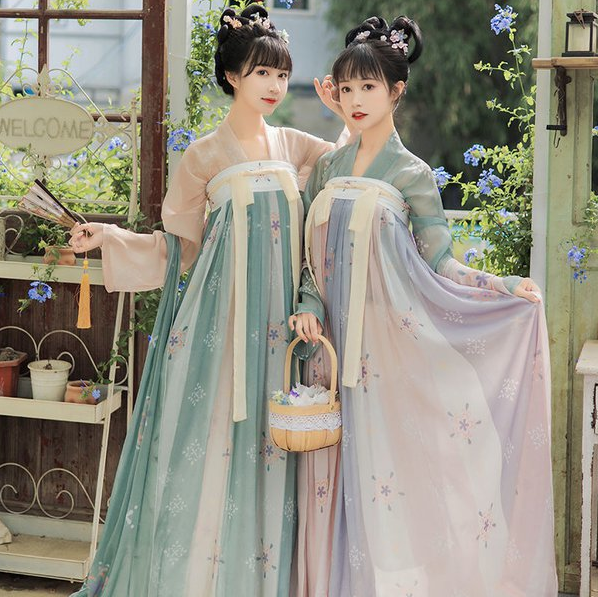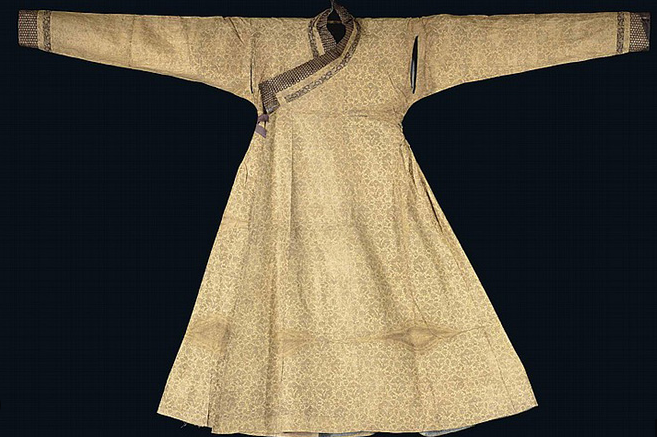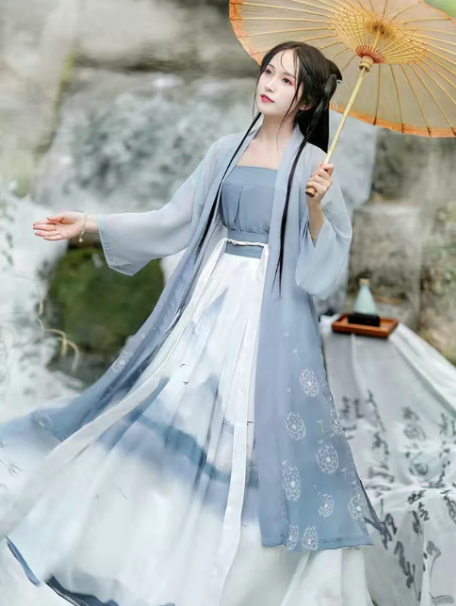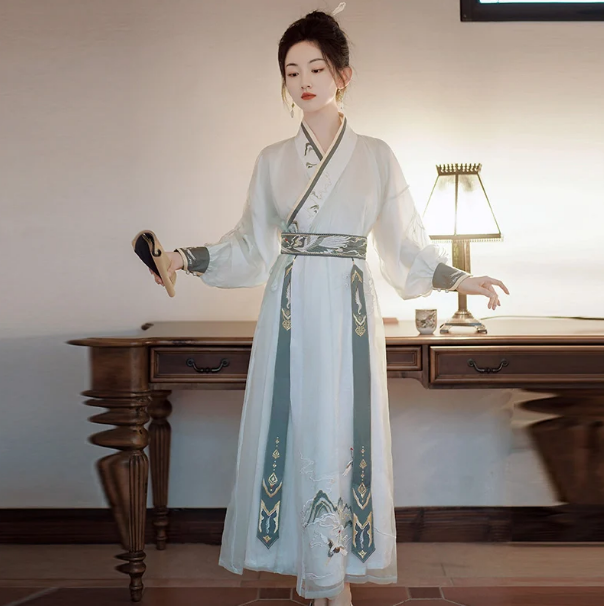Introduction to Hanfu: Understanding Traditional Chinese Attire
Origins and Evolution of Hanfu
Hanfu, the traditional clothing of the Han Chinese people, dates back over 4,000 years. It not only symbolizes Chinese culture but also reflects historical aesthetics and social customs. Initially inspired by the clothing styles during the Han Dynasty, Hanfu has evolved, mirroring changes in Chinese politics, culture, and art. Hanfu’s rich history intertwines with the evolution of ancient Chinese civilization.
Characteristics of Hanfu
Distinct in its design, Hanfu usually comprises several layers and a unique silhouette, characterized by flowing robes, wide sleeves, and a belt to cinch the waist. The materials range from silk to linen, varying according to season and social status. The colors and decorations of Hanfu often held symbolic meanings, representing the wearer’s social rank and philosophical or moral beliefs.

Hanfu in Ceremonies
In traditional Chinese culture, Hanfu wasn’t just daily wear but also played a crucial role in rituals and ceremonies. During these events, the choice of Hanfu was meticulous, considering factors like age, social position, and the specific ritual’s nature. Each ceremony had its set of dress codes, emphasizing the importance of respect and etiquette in Chinese culture.
Modern Hanfu Movement
The Hanfu movement has seen a resurgence in recent years, especially among young people. It’s a symbol of cultural pride and a way to connect with Chinese heritage. This revival isn’t just about wearing traditional clothes but also involves learning about the philosophies, literatures, and rituals of ancient China. Today’s Hanfu combines traditional styles with modern fashion elements, making it popular in various settings, from festivals to casual wear.
Significance
Hanfu goes beyond being just an item of clothing; it’s a profound expression of Chinese identity and cultural continuity. It embodies the aesthetics, values, and history of the Han people, making it an invaluable part of China’s cultural heritage.
Through this introduction, we can see Hanfu as more than clothing. It’s a cultural symbol, loaded with historical significance and modern relevance, bridging the past and present of Chinese culture.
Historical Overview of Sacrificial Ceremonies and Attire in Ancient China
The Role of Sacrificial Ceremonies
Sacrificial ceremonies in ancient China played a vital role in connecting the living with the spiritual world. They involved offering goods and prayers to deities or ancestors, seeking blessings, good harvests, and peace. Rulers and nobles often conducted these ceremonies to maintain harmony and order in the kingdom.
Evolution of Sacrificial Attire
The attire worn during these ceremonies, crucial for their execution, evolved significantly through different dynasties. Each dynasty had its specific styles, colors, and designs, reflecting the period’s customs and beliefs. Silk, a highly valued material in ancient China, was commonly used for making these ceremonial robes.
Design and Symbolism
The design of sacrificial attire was not arbitrary. It followed strict guidelines about colors, embroidery, and patterns, each element holding a symbolic meaning. Red, for instance, symbolized good fortune and joy, while dragons embroidered on robes represented power and authority. This attire was more than just clothing; it was a medium through which the Chinese expressed respect and piety towards the spiritual world.
Hanfu in Sacrificial Ceremonies
Sacrificial ceremonies often required specific types of Hanfu. These were elaborate, distinguished by their fineness and intricate details. The garments typically featured layers, with the Yi (衣, a draped garment) and the Shang (裳, a long skirt) being prominent components. The sophistication and quality of these clothes reflected the solemnity and significance of the ceremonies.
Impact on Chinese Culture
These sacrificial rites and their associated attire have profoundly influenced Chinese culture, arts, and literature. Traditional Chinese festivals and ceremonies today still draw inspiration from these ancient practices, showcasing the continuity and enduring legacy of China’s rich cultural heritage.
Sacrificial ceremonies and the attire worn were central to ancient Chinese society, symbolizing a deep-rooted connection with the divine and ancestral worlds. They showcase the intricacies of Chinese culture and its enduring influence through time.
Analyzing the Elements of Sacrificial Gowns: Fabric, Design, and Symbolism
Fabric Choice in Sacrificial Gowns
The fabric of sacrificial gowns held great importance in ancient Chinese rituals. Silk, revered for its texture and sheen, was the predominant choice. The quality of silk used often indicated the status and the respectability of the wearer. Higher-grade silk with finer weaves was common among nobles and the royal family. The use of silk in these gowns wasn’t just a matter of luxury but a testament to its cultural significance in China.
Design Elements of Sacrificial Gowns
The design of sacrificial gowns, complex and meaningful, involved precise tailoring. They often featured layers and long sleeves, symbolizing dignity and grace. The length, cut, and width of the gowns varied, each adhering to the social ranks and the type of ceremony. Intricate embroideries, usually of dragons, phoenixes, and other mythical creatures, adorned these gowns, each adding to the garment’s solemnity and splendor.
Symbolism in Colors and Patterns
Colors and patterns in sacrificial gowns weren’t just for aesthetic appeal; they carried deep symbolic meanings. Red, often used, symbolized good fortune and joy, while yellow, typically reserved for the emperor, represented power and the center of the universe. Patterns like clouds, mountains, and waves were common, symbolizing the connection between nature and the spiritual realm.
Meaning Behind Embroideries
Embroideries in sacrificial gowns also had symbolic significances. Dragons, a dominant motif, symbolized power and imperial authority. Phoenixes represented renewal and virtue. Even the number of embroidery motifs followed specific rules, often related to numerology and cosmology in Chinese culture.
Impact on Socio-cultural Values
These gowns reflected the socio-cultural values of the time, emphasizing hierarchy, spirituality, and the deep interconnection between human and celestial realms. The attention to detail and the richness of symbolism in these gowns underline the reverence ancient Chinese society held for rituals and traditions.

Sacrificial gowns in ancient China were more than mere garments; they were a canvas for expressing spiritual beliefs, social order, and cosmological ideas. Every thread and color in these gowns narrated stories of reverence, respect, and connection to the divine.
Comparing Sacrificial Gowns and Hanfu: Similarities and Differences
Similarities in Design and Form
Both sacrificial gowns and traditional Hanfu share a common lineage in Chinese clothing history, emphasizing elegance and flowing lines. They often feature layers, wide sleeves, and were typically made from silk. The emphasis on these elements in both types of attire highlights the continuity in Chinese sartorial traditions.
Differences in Usage and Symbolism
Sacrificial gowns, as the name suggests, were specifically for rituals and ceremonies, whereas Hanfu encompassed a broader range of everyday and formal wear. The colors, patterns, and designs of sacrificial gowns were often more elaborate, each tailored to specific ceremonies and their associated symbolism. Hanfu, while still elegant and symbolic, served a more general role and did not adhere as strictly to symbolic rules as sacrificial gowns.
Material and Quality Variations
The material quality of sacrificial gowns was typically higher than that of regular Hanfu. The finest silks and most intricate embroideries were reserved for these gowns, reflecting the solemnity and importance of the ceremonies they were associated with. Hanfu, though still using quality materials, varied more in terms of fabric and decoration based on the wearer’s social status and the occasion.
Evolution Over Time
While both sacrificial gowns and Hanfu have evolved over centuries, the changes in Hanfu have been more pronounced. Hanfu’s transformation reflects shifts in social customs, dynastic changes, and fashion trends. Sacrificial gowns, tied closely to ritual and tradition, have retained more of their traditional designs and meanings.
Contemporary Influence and Revival
In recent years, there’s been a revival of interest in both sacrificial gowns and Hanfu, particularly among younger generations in China. This resurgence is part of a broader movement to reconnect with and celebrate Chinese cultural heritage. While Hanfu has become popular in daily wear and at cultural events, sacrificial gowns are primarily seen in historical dramas, ceremonial reenactments, and cultural exhibitions.
By comparing sacrificial gowns and Hanfu, we gain insights into the rich tapestry of Chinese clothing traditions, each with its unique place in the history and culture of China. Both reflect the values, aesthetics, and philosophies of the Chinese people, though in different contexts and modes of expression.

The Role of Hanfu in Modern Chinese Culture and Ceremonies
Hanfu as a Symbol of Cultural Identity
In modern China, Hanfu has transcended its role as traditional attire to become a symbol of Chinese cultural identity. Young people, in particular, wear it to express pride in their heritage. This trend reflects a growing interest in reconnecting with and preserving the rich history of China.
Hanfu in Contemporary Ceremonies
Today, Hanfu features prominently in traditional festivals like the Lunar New Year and the Mid-Autumn Festival. Participants wear it to perform ancient rites and dances, bringing historical customs to life. Its use in weddings has also surged, with couples choosing Hanfu to honor their roots in a modern context.
Influence on Fashion and Media
The resurgence of Hanfu has significantly influenced Chinese fashion and media. Designers often integrate elements of Hanfu into contemporary clothing, blending ancient styles with modern aesthetics. Hanfu also appears frequently in Chinese films and television, often in historical dramas, popularizing its styles and patterns among wider audiences.
The Role of Social Media and Hanfu Communities
Social media platforms and Hanfu enthusiast communities play a crucial role in popularizing the attire. Online communities share styling tips, historical facts, and organize Hanfu-related events, fostering a sense of belonging among fans. These platforms also help in educating people about the significance of Hanfu in Chinese culture.
Challenges and Perceptions
Despite its popularity, Hanfu faces challenges in broader acceptance due to its association with historicism and nationalism. Debates continue about the practicality of wearing Hanfu in everyday life. However, its increasing presence in public life indicates a growing acceptance and interest in traditional Chinese culture.
Hanfu’s role in modern Chinese culture extends beyond fashion; it acts as a bridge between past and present, offering a unique way to explore and celebrate Chinese heritage. Its growing presence in ceremonies, media, and daily life underscores its importance as a cultural icon in contemporary China.
Conclusion: The Cultural Significance of Sacrificial Gowns within the Hanfu Tradition
Integrating Historical and Cultural Values
Sacrificial gowns in the Hanfu tradition exemplify the deep integration of China’s historical and cultural values. These gowns, used in rituals, connect contemporary society with its ancient past, reflecting values like respect for ancestors and the spiritual world.

Symbolism and Continuity in Chinese Culture
The intricate designs and patterns of sacrificial gowns are rich in symbolism. Dragons, phoenixes, and other mythical creatures often adorn these garments, symbolizing power, nobility, and good fortune. Their use in modern times continues a cultural legacy spanning thousands of years.
Preserving Traditional Craftsmanship
The creation of sacrificial gowns preserves traditional Chinese craftsmanship. Skills like silk weaving, embroidery, and dyeing are crucial in making these garments. Each gown stands as a testament to the artisan’s skill, dedication, and the importance of preserving these techniques.
Educational and Inspirational Role
Sacrificial gowns serve an educational purpose by providing tangible links to Chinese history and philosophy. They inspire interest in traditional customs, rituals, and the broader Hanfu movement, particularly among younger generations seeking to explore their cultural identity.
The Future of Sacrificial Gowns in Hanfu Tradition
While primarily seen in ceremonial contexts today, the growing popularity of sacrificial gowns and Hanfu in general points to a broader revival of interest in traditional Chinese attire. Their presence in cultural festivals, ceremonies, and media indicates a sustained, if not growing, role in Chinese culture.
In summary, sacrificial gowns within the Hanfu tradition embody the continuity and evolution of Chinese cultural heritage. They not only connect the past with the present but also play a pivotal role in the preservation and promotion of traditional values, arts, and crafts. As symbols of China’s rich history and living traditions, they continue to inspire and educate, ensuring that the essence of Chinese culture is passed on to future generations.







